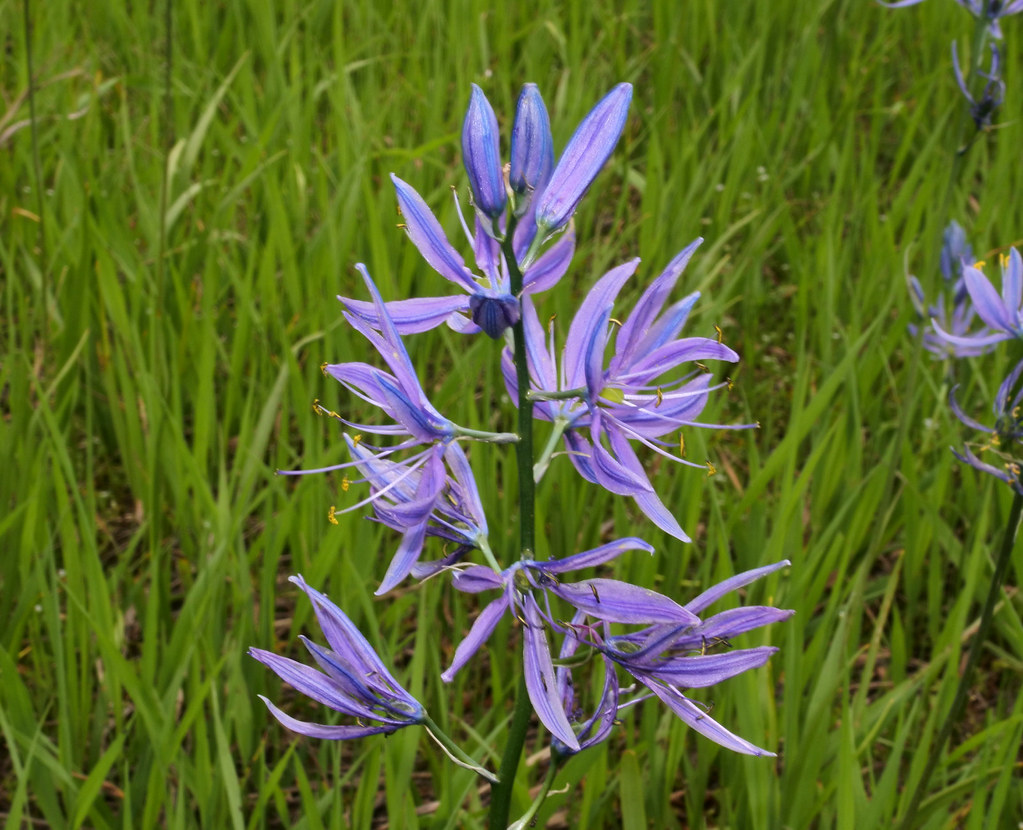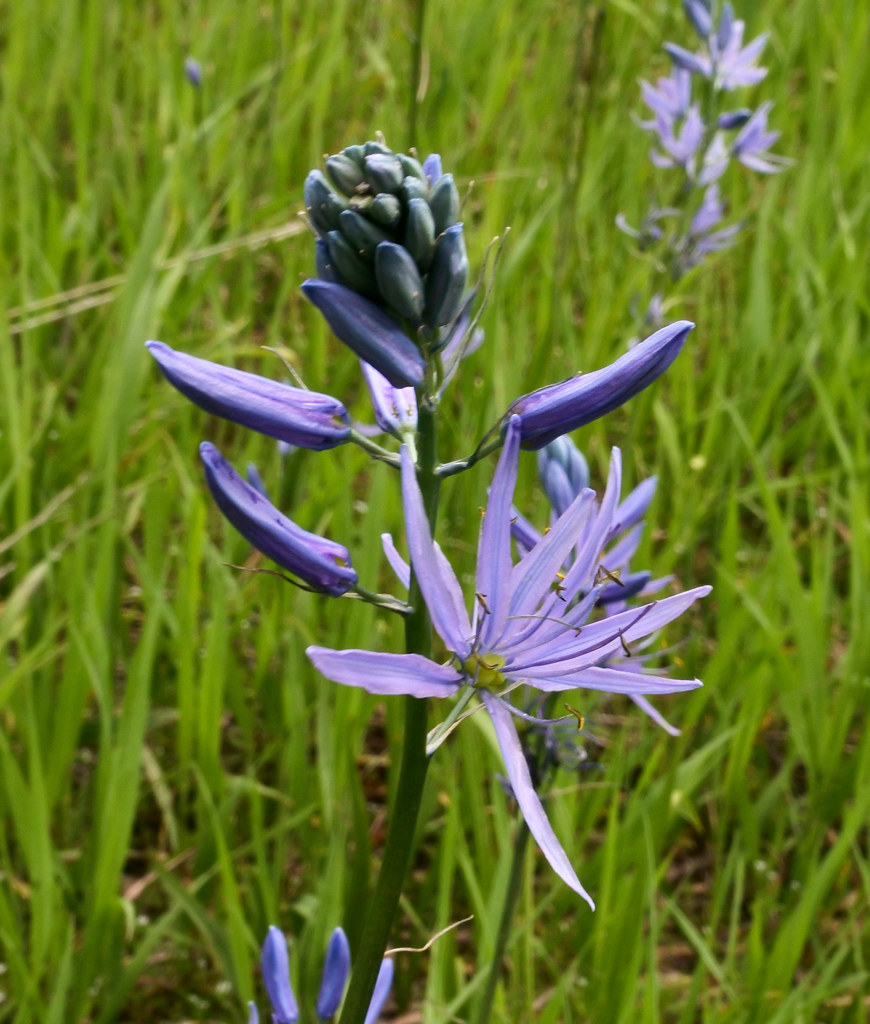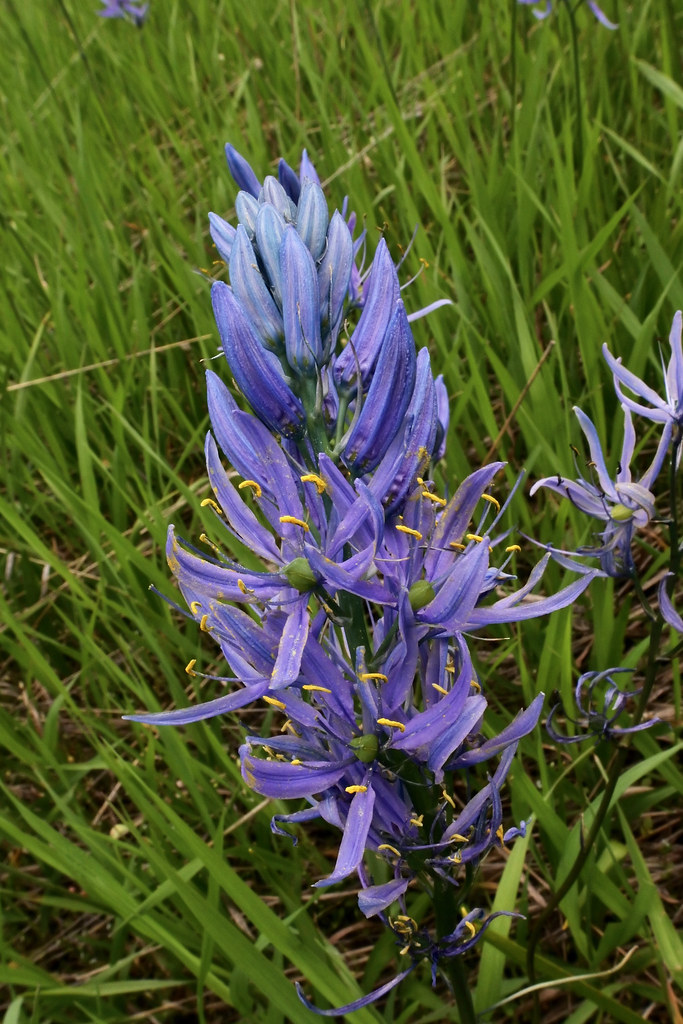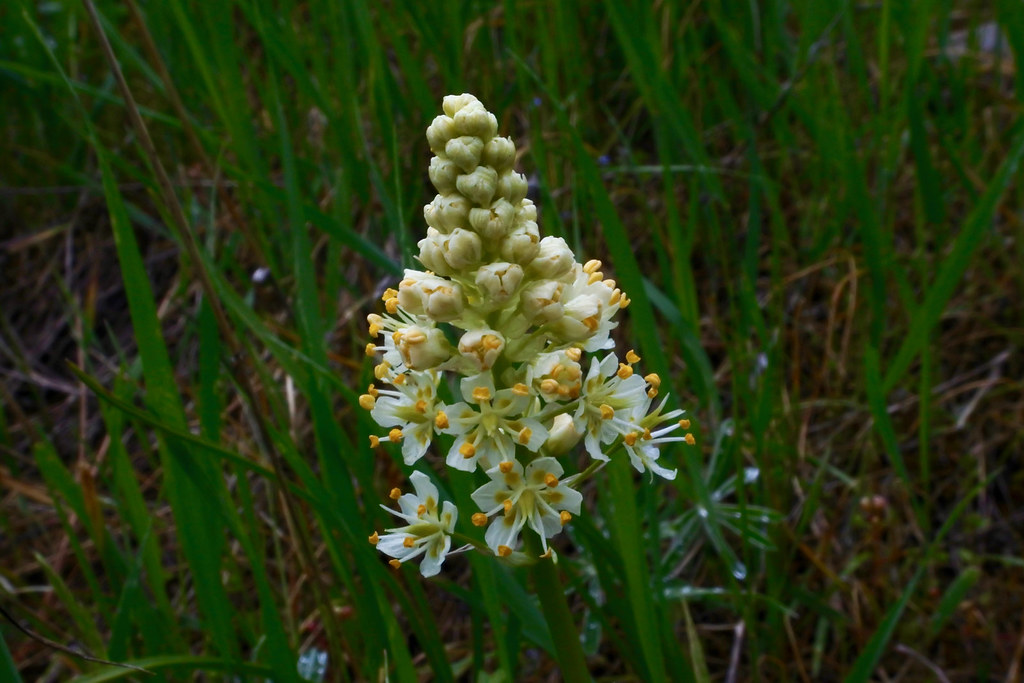May 17, 2017
There are Camas, and there are Camas…






Common Camas or Blue Camas ~ Cammassia quamash
The bulbs of the Blue Camas, which are starchy, nutritious and have a high sugar content were an important food source for the indigenous tribes in the west and northwest parts of the U.S. and Canada. Many Indian wars were fought for the collecting rights to cherished camas meadows, and as the explorers (including Lewis & Clark and Discovery), trappers and early settlers arrived they also depended on the Camas bulbs for some of their sustenance. “Camas Prairie” is a well known place name in an area close to where I live and also in an area in eastern Idaho as well as other areas across the west.
The other Camas however, is deadly.

Meadow Death Camas ~ Zigadenus venenosus is, as the name implies, extremely toxic and can cause death in people and cattle or other animals that graze on them and a big problem is that its bulb is nearly identical in looks to the bulb of the Blue Camas. I hate to think about just how it was discovered that they were deadly toxic to humans!
RSS feed for comments on this post. TrackBack URI
I’ve often wondered about that too. How do people find out if a plant is poisonous or not? The camas are both beautiful flowers, but the blue one has that perfect shade of blue that I like so much.
LikeLiked by 1 person
Comment by wordsfromanneli — May 17, 2017 @ 10:01 am
I imagine they mentioned it a few times on those pre-historic death certificates before they figured it out or maybe someone just had a little taste and got very sick… Last week I drove through the area near here that’s known as Camas Prairie and there were large stands of it in bloom: they are beautiful!
LikeLiked by 1 person
Comment by montucky — May 17, 2017 @ 10:13 am
They really are beautiful flowers. But I’m glad we aren’t expected to find our food out in those fields anymore.
LikeLiked by 1 person
Comment by wordsfromanneli — May 17, 2017 @ 1:43 pm
I’m afraid I would have to get a lot better at it than I am now.
LikeLiked by 1 person
Comment by montucky — May 17, 2017 @ 6:48 pm
I remember you posting sometime back that you used to go out and harvest these bulbs with the local Indians and they had given you a name I believe. You noted that the bulbs look almost alike so I guess the only way to make sure that you get the right one is to pick those growing underneath the purple flower. BTW I enjoyed your pictures of the Spring Creek trail. Keep on hiking and posting!
LikeLiked by 1 person
Comment by Ron Mangels — May 17, 2017 @ 11:18 am
Hi Ron! I have no experience with these plants; it was the Bitterroots that the Indians let me help harvest every summer. I doubt that they would have trusted me to select the right Camas bulbs. Both species of Camas are now in bloom, but I saw none of the Death Camas in the area where the blue ones were growing so well. The Death Camas photo in the post was taken on the hillside just above my house though.
It’s still about a month or so away from hiking up higher. The snow line is between 4,000 and 5,000 feet still. It snowed though last night and not far from my house they got over two inches
LikeLike
Comment by montucky — May 17, 2017 @ 11:27 am
Great post! Beautiful photographs!
LikeLiked by 1 person
Comment by kkessler833 — May 17, 2017 @ 11:26 am
Thank you! I love these cloudy/rainy days: they are excellent for wildflower photography!
LikeLiked by 1 person
Comment by montucky — May 17, 2017 @ 11:29 am
Welcome! I agree! I live to paint but I do have some photos in my portfolio. Have a great day!
LikeLiked by 1 person
Comment by kkessler833 — May 17, 2017 @ 11:34 am
Eating the wrong camas is bad.
LikeLiked by 1 person
Comment by Malcolm R. Campbell — May 17, 2017 @ 12:31 pm
And final.
LikeLiked by 1 person
Comment by montucky — May 17, 2017 @ 12:53 pm
Trial and error was the only way and I’m sure a lot of native people suffered terribly.
The blue camas are beautiful flowers. I was surprised when you said they were edible but I had them mixed up with the death camas, neither of which grow here. A meadow full of them must be astonishing.
LikeLiked by 1 person
Comment by New Hampshire Garden Solutions — May 17, 2017 @ 3:18 pm
And I wonder how good the communication was way back then: were they able to spread the word about a dangerous plant?
The blue camas is the only wild flower I can think of here other than the Dandelion perhaps, that will cover a very large area, and the delicate sheen of blue is wonderful to see, especially if there is a gentle breeze to stir the blossoms.
LikeLiked by 1 person
Comment by montucky — May 17, 2017 @ 6:53 pm
Wow, it does make you wonder how many people died before the word got out since communication back then was so slow and sparse. It would have taken a lot of bravery to start eating unknown plants or extreme hunger.
LikeLiked by 1 person
Comment by Candace — May 17, 2017 @ 4:19 pm
And then one might wonder if they even told their enemies. Those folks were very attuned to the natural world though and I’m sure they saw thing is far greater detail than we do now.
LikeLike
Comment by montucky — May 17, 2017 @ 6:55 pm
I imagine the early settlers must have only chosen bulbs out of a field of the blue variety (for planting larger new fields) back in the early settlement days OR I might suggest Native Americans could probably tell the difference? I love your photos of the fields in Spring. Gives one a sense of how pretty they must look as you walk through the area.
LikeLiked by 1 person
Comment by Vicki — May 17, 2017 @ 6:02 pm
I have never read anything about the indigenous people planting them: my impression was that they simply visited the natural meadows to dig the bulbs and did so while the plants were in flower to be sure of the species. I’d also guess that they were able to differentiate the two bulbs is some way besides.
LikeLiked by 1 person
Comment by montucky — May 17, 2017 @ 6:59 pm
I thought about mushrooms. When I lived in Iowa, I loved those spring morels, but they’re quite distinctive and easy to identify. Otherwise? I wouldn’t dare eat anything I picked up. I know people who eat the big one called chicken-of-the-woods, and it’s pretty distinctive, too. Still, it seems an iffy proposition. Bulbs would be even harder. I never had noticed how much the bud of the blue camas resembles a banana pepper. 🙂
LikeLiked by 1 person
Comment by shoreacres — May 17, 2017 @ 6:07 pm
Other than berries, there are very few wild foods that I will eat. Camas, cattail, bitterroot, clover, morels, giant puffballs and arrowleaf balsam root are about it for me. I feel much more confident about berries though and eat many different species of them.
LikeLiked by 1 person
Comment by montucky — May 17, 2017 @ 7:05 pm
Even with berries, caution seems advised. When I first moved to California, I found something that looked for all the world like a wild strawberry. I tried one, and wished I hadn’t, as I could feel my heart rate going up. No harm was done, but that was the end of my plucking anything I couldn’t identify for certain.
LikeLike
Comment by shoreacres — May 17, 2017 @ 7:08 pm
There are some berries that I don’t touch because I’m not familiar with their effects, but many more in which I do have confidence and have enjoyed for years. My favorite is Serviceberry (Saskatoon). Also pine seeds: we don’t have wild nuts in this area.
LikeLike
Comment by montucky — May 17, 2017 @ 7:23 pm
What beautiful flowers! I had never heard of Camas. Thank you also for the mention of Lewis and Clark – I will be reading more about them!
LikeLiked by 1 person
Comment by Jo Woolf — May 18, 2017 @ 1:59 am
I haven’t found a good source for distribution of plant species outside of North America, but here these are native only in about seven western US states and western Canada.
LikeLiked by 1 person
Comment by montucky — May 18, 2017 @ 7:33 am
Beautiful! I’m with you .. so many toxic flowers, mushrooms .. someone had to find out didn’t they! Oh dear ..
LikeLiked by 1 person
Comment by Julie@frogpondfarm — May 19, 2017 @ 11:00 pm
I like to think that in most cases the first experience was a mild case of sickness.
LikeLiked by 1 person
Comment by montucky — May 20, 2017 @ 9:15 am
Very beautiful.
LikeLiked by 1 person
Comment by Sartenada — May 24, 2017 @ 2:21 am
Thank you!
LikeLike
Comment by montucky — May 24, 2017 @ 8:10 am